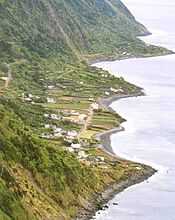Fajã dos Vimes
| Fajã dos Vimes | |
| Debris Field (Fajã) | |
| A view of the Fajã from the coastal roadway leading down to the village | |
| Named for: Wicker | |
| Country | |
|---|---|
| Autonomous Region | |
| Group | Central |
| Island | São Jorge |
| Municipality | Calheta |
| Civil parish | Ribeira Seca |
| Rivers | Ribeira dos Vimes, Ribeira do Capadinho, Grota do Moledo |
| Biomes | Temperate, Mediterranean |
| Geology | Alkali basalt, Tephra, Trachyte, Trachybasalt |
| Orogeny | Volcanism |
| Period | Holocene |
| Management | Secretário Regional do Ambiente e do Mar |
| - location | Rua Cônsul Dabney - Colónia Alemã, 140, Horta, Faial |
| - elevation | 28 m (92 ft) |
| - coordinates | 38°32′2″N 28°37′45″W / 38.53389°N 28.62917°W |
| Owner | Regional Government of the Azores |
| For public | Public |
| Visitation | Accessible by foot, yet restricted during periods of inclimate weather |
| Easiest access | By dirt trail from Fajã da Fonte dos Bodes and Fajã da Fragueira[1] |
| Geographic detail from CAOP (2010)[2] produced by Instituto Geográfico Português (IGP) | |
The Fajã dos Vimes is a permanent debris field, known as a fajã, built from the collapsing cliffs on the southwest coast of the civil parish of Ribeira Seca, in the municipality of Calheta, island of São Jorge, in the Portuguese archipelago of the Azores.
History

In November 1661, the municipality of Calheta ordered the hunting of rodents and birds in this region; each farmer was required to provide 20 rabbit pelts, 30 rat pelts and 30 birds. This was referred to, at the time, as the O Imposto para a Salvação do Trigo (A Tax for the Salvation of Wheat), and required each farmer to own a dog and ferret, in order to keep their lands clear of these nuisance animals.
At a time when the hermitage of São Sebastião was the seat of the parish, there was a resident clergy supporting a population of 500 local inhabitants and other fajãs. Since this period, the chapel was abandoned and the region integrated into the parish of Ribeira Seca.
The 1757 earthquake (which was assumed to be a magnitude 7.4 on the Richter Scale) was responsible for destroying the original settlement, resulting in the deaths of 1034 people across the island. Of these, 128 people were discovered near the churchyard in the fajã, including the vicar and members of the local clergy. The earthquake caused several landslides, rockfalls and movements of land that resulted in the creation of several new fajãs around the island, such as in Fajã da Ponta Nova. As a consequence of these events, King Joseph ordered, by royal decree, that the rents paid to Terceirense landowners be abrogated.
There are three fountains that date to 1882 and 1883, while the third (alongside the church) that is undated.
The fajã was one of the unique places to have a school established, inaugurated on 12 April 1886, and who by 1993 still maintained a small class of 11 students.[1]
The port of the fajã suffered great destruction flowing the 3 February 1899 earthquake, which affected the southern coast of São Jorge.
A 1992 tropical storm, Hurricane Bonnie, resulted in excess rainfall in the lands over the fajã, resulting in the destruction of the main bridge.
Geography
The fajã is occupied by a small population of about 70 residents throughout the year.[1]
The waters of Ribeira dos Vimes, Ribeira do Capadinho and Grota do Moledo (sometime Grotão do Moledo), in the area referred to as Tabuleiro, are responsible for supporting five historic watermills, all in bad states of conservation.[1]
Fishing was an important part of the local economy and part of the subsistence lifestyle that permeated the early location. Its fertile soils, supported by a warm microclimate, allowed the cultivation of corn, rye, grapes, potato, beans and tarot (with the latter two being the predominant cultures), while a low-volume coffee culture also developed.[1]
Culture
This fajã is recognized for the quilts and artesnal textiles produced in the community, since it uses the ancient techniques that includes ancient wooden looms.[1]
The historic Chapel of São Sebastião was established by Lay Carmelites, and the feast day (16 July) continues to be celebrated in the fajã.[1] Another festival that is very popular, is the feast day of the Corpo de Desu, when many Jorgenses and visitors travel to the fajã, and eat fried fish, limpets, tarot and potato accompanied with wine.[1]
References
- Notes
- Sources
- Cordoso, Ana (March 2012), Fajã dos Vimes (in Portuguese), SRAM Secretária Regional do Ambiente e do Mar, retrieved 4 February 2015